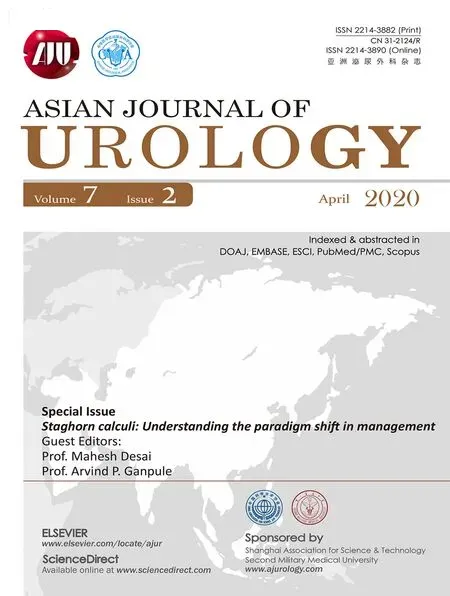Robot-assisted laparoscopic prostatectomy:How can we get better?
Prostate cancer(PCa)is the second most common cancer in men with 17 million new cases in 2018 and 27 million new cases expected by 2040 [1]. Mortality is however declining which may reflect improvements in the treatments available [2]. One such treatment is the robot-assisted laparoscopic prostatectomy (RALP) which was first performed in 2000 at the Department of Urology of Frankfurt University in Germany. Initial adoption was limited due to the lack of data supporting its safety and efficacy in terms of functional and oncological outcomes until the landmark studies published by Menon et al. [3,4]. This paved the way for further studies such as the Swedish LAPRO trial. This revealed a moderate advantage for erectile dysfunction with RALP, compared to open radical retropubic prostatectomy (RRP), and no significant difference between the two in terms of cancer relapse at the 24-month follow-up[5]. Consequently, the Da Vinci Robot is currently used worldwide, with an estimated 300 000 urology procedures being performed in 2018 [6].
Higher-volume centres have traditionally been associated with more favourable outcomes across a wide range of surgical procedures and conditions [7]. These have significant implications on both training and adoption of new techniques. As such, it is imperative to calculate the number of cases a surgeon needs to perform to ensure competency and safety at any new technique.
This learning curve is influenced by patient factors such as case mix and surgeon related factors like attitude,confidence and experience in other procedures. It also differs depending on the desired outcome. For example,the number of cases required to reduce positive surgical margins (PSMs) may be 300 while reducing the mean estimated blood loss (EBL) may only require 200.
In an attempt to quantify the RALP-related learning curve, multiple studies have been performed, each focusing on different surgical outcomes and using surgeons with varying degrees of experience. The most notable of these studies was a retrospective analysis of 3 794 patients undergoing RALP, performed by three different surgeons,between January 2003 and September 2009 conducted by Sooriakumaran et al.[8].This revealed that greater surgical experience resulted in an improved PSM rate and operative time (OT), but this required over 1 600 cases for a PSM of <10% and 750 cases for OT to plateau. This suggested a longer than expected learning curve,limiting its use to high volume surgeons to optimise patient outcomes.
In this study, a laparoscopic na?ve surgeon’s experience with 500 patients in mainland China was monitored and the RALP learning curve characterised in terms of OT,EBL,PSM,biochemical recurrence (BCR), postoperative continence and length of stay (LOS). A transperitoneal approach with six trocar access points and a conventional four-arm Da Vinci Robotic System was used.
The study identified that the OT and EBL declined initially, reaching a plateau at 200 cases, followed by a second dramatic decline after 400 cases. A similar pattern was also observed with the postoperative LOS, with a plateau reached after 200 cases. In terms of postoperative continence, only 3.8% of patients were incontinent at the 36-month follow-up, while the BCR rate was 14.2% 13-months postoperatively. Unlike Sooriakumaran et al. [8]however, the PSM remained at 21.8% overall, with no significant reduction being observed with increased expereince. These results are in-keeping with the outcomes of other high-volume centres which suggest that despite the efficacy of RALP,further treatment with either radiotherapy(RT) or chemotherapy is required to improve survival.
Studies such as radical radiotherapy (Radicals-RT) and SPCG-15 are therefore very important. Radicals-RT is a randomised controlled trial (RCT) which suggests that early salvage RT should be the standard treatment of care after radical prostatectomies (RPs), instead of adjuvant RT, a finding supported by the ARTISTIC meta-analysis [9]. This recommendation is based on both treatment modalities offering similar outcomes for event-free survival,but salvage RT spares many men from RT and its associated side-effects.
SPCG-15 goes one step further, aiming to investigate whether RP±RT improves cause-specific survival compared to primary RT and androgen deprivation treatment in patients with locally advanced PCa[10].This RCT is currently underway, with patient recruitment ending in 2022, and is likely to impact the future management of PCa, making it an important trial to follow.
In conclusion,RALP is a safe,minimally invasive procedure with good oncological outcomes and desirable functional results.Nevertheless,to achieve expertise in this technique,with a reduction of PSM to <10% , a longer than expected learning curve is required, limiting its use to high-volume centres.Additionally,further work is required to identify the ideal treatment modality to improve survival post-RP.
Conflicts of interest
The authors declare no conflict of interest.
Nicolas Omorphos
Hertfordshire and Bedfordshire Urological Cancer Centre,
Department of Urology, Lister Hospital, Steveange, UK Nikhil Vasdev*
Hertfordshire and Bedfordshire Urological Cancer Centre,Department of Urology, Lister Hospital, Steveange, UK School of Medicine and Life Sciences, University of Hertfordshire, Hatfield, UK
*Corresponding author.E-mail address: nikhilvasdev@doctors.org.uk (N. Vasdev)11 November 2019
 Asian Journal of Urology2020年2期
Asian Journal of Urology2020年2期
- Asian Journal of Urology的其它文章
- Management of staghorn stones in special situations
- Preoperative imaging in staghorn calculi,planning and decision making in management of staghorn calculi
- Staghorn calculi: Understanding the paradigm shift in management
- Carcinoma bladder and sliding bladder hernia: Unusual association of paramount significance
- Total pelvic exenteration and a new model of diversion for giant primitive neuroectodermal tumor of prostate: A case report and review of the literature
- A prospective study of patient reported urinary incontinence among American,Norwegian and Spanish men 1 year after prostatectomy
